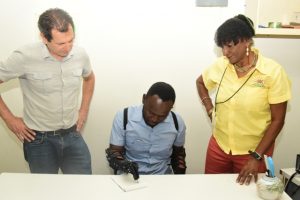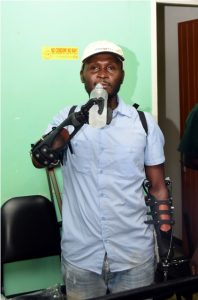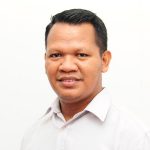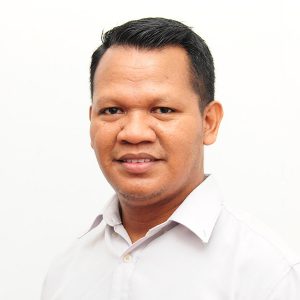-amputee receives new mechanical arms
He walked around the room with a smile on his face. He said he felt like a miracle had come his way. Today Melroy Pyle, who lost both of his hands last December due to electrical shock, is more jovial than he ordinarily is.
Last week, the 37-year-old father of four received a new pair of mechanically engineered prosthetic arms, thanks to the generosity of renowned Clinical Prosthetist/Orthotist , Jonathon Batzdorff , the Director of the California –based non-profit organization ProsthetiKa.
ProsthetiKa helps improve the lives of physically disabled people around the world, mainly those persons who require artificial limbs and orthopedic braces.The organisation’s mission is to provide appropriate and sustainable assistance to disables people in developing countries, according to its motto.

Pyle is a patient of the National Orthotic and Prosthetic Appliance Workshop at the Ptolemy Reid Rehabilitation Centre on Carmichael Street.
Through correspondences which were exchanged between the centre’s director, Cynthia Massay , British traveler David Nicholas and Batzdorff, the California –based organization learnt of Pyle’s accident back in December.
A team of experts, which includes Batzdorff , Ian Carrick of RSF International Inc of Canada and England-based Laura Burgess , Clinical Specialist Physiotherapist, met with patients undergoing rehabilitation at the centre. It was there that the team encountered Pyle for the first time last Monday.

According to Massay, Pyle has been receiving support from the centre and according to her , never in her wildest dream did she expect the visiting team to “actually bring along equipment to help him on the spot.”
She said within a day of Pyle being fitted with his new arms, the young man was signing his name, drinking water from the bottles, even playing around with a cricket ball at the centre.”It was the most amazing thing,” she said. It was noted too that due to the high cost of production, few individuals globally are able to afford the device.
How does it work?
The arms work with a “tension mechanism “ , Batzdoff said. It is fitted with cables connected to straps which are placed on the patient’s back. Once the straps connect to the back, the muscles contract and the tension enables the patient to move the mechanical fingers as well as the arm.
It works through the concept of an ‘automatic’ body-powered upper limb prosthesis which was pioneered by German dentist Peter Baliff in the year 1818.
Through the transmission of tension through leather straps, Baliff’s device enabled the intact muscles of the trunk and shoulder girdle to elicit motion in a terminal device attached to the amputation stump. For the first time, an amputee was able to operate his prosthesis with fluid body motions, rather than as a distinct foreign object. Ever since, variations have evolved and ProsthetiKa is one of the world’s leading scientific organisations behind new inventions geared at assisting persons with disabilities.
How important is one’s hand?
The hand is an integral component of the human body, with an incredible spectrum of functionality.
According to research compiled by the United States based National Center for Biotechnology Information (NCBI)), in addition to possessing gross and fine motor capabilities essential for physical survival, the human hand is fundamental to social conventions, enabling greeting, grooming, artistic expression and syntactical communication.
Pyle was amputated from the elbows down. He said that there was nothing much the doctors could have done to save his hands, a situation which devastated the Cove and John , East Coast Demerara resident at the time.
Research compiled by Doctors Kevin Zuo and Jared Olson and reproduced by the NCBI indicates that the loss of one or both hands is, thus, a devastating experience, requiring significant psychological support and physical rehabilitation.
The majority of hand amputations occur in working-age males, most commonly as casualties sustained during combat or as a result of work-related trauma.This is what occurred in Pyle’s case.
The upbeat Pyle told the Guyana Chronicle that he is civil engineer student at the University of Guyana. It was on December 18th, 2017 when life changed for him. Between smiles, he said on the day in question, he had a chemistry exam at the university during the morning hours. He said after the exam, he went to work on the building where he was “catching a hand” and to gain practical experience with a company undertaking works at the Turkeyen campus.
Around 1300hrs that day the workers were preparing to structure the beams at the building and he recalled seeing a live electrical wire some four feet away from the building. “The steel I was handling came in contact with the wire, 14000 volts, and I just thank God I’m alive,” he said.
Pyle noted that although he was knocked to the ground, he was conscious about what was happening because he heard voices. “I could have heard them saying, he alive,” he added, noting that the heat burned off his wrists.
But how has life been since?
“It is a different life because, nobody plans to lose a limb, it is something new in your life, you try to work around what happened to you,” the man noted with positive nods. He said he found a way to live with his situation. “Well I am always positive about everything,” he said.
Last week, fitted with his new hands, Pyle was able to visit a Scotiabank location and was able to sign his name in order to undertake a transaction.
As for his family, he said his wife and four children have grown even closer to him following the incident. “Most people see you as an amputee and wonder how you deal with it but never think about how your family deals with it,” he said.
Pyle’s wife, who is a teacher and who was also studying at the university, took time-off to attend to him. “With this new hand it is better for all of us because I could do things for myself, I may not be able to do everything but I can do a lot, I can actually hold a bag and walk with it,” he said with a smile.
He expressed appreciation to Massay and the centre’s Orthotic and Prosthetic Appliance Workshop, the only one of its kind in Guyana which caters to persons with disabilities throughout the country.
According to Pyle, the visiting team performed a miracle last week. He said that thanks to Jon and the team, he can now “live life as I would want to.”
Among Pyle’s plans is to continue his studies at the University of Guyana and to accomplish most of his dreams by the grace of God.



.jpg)










